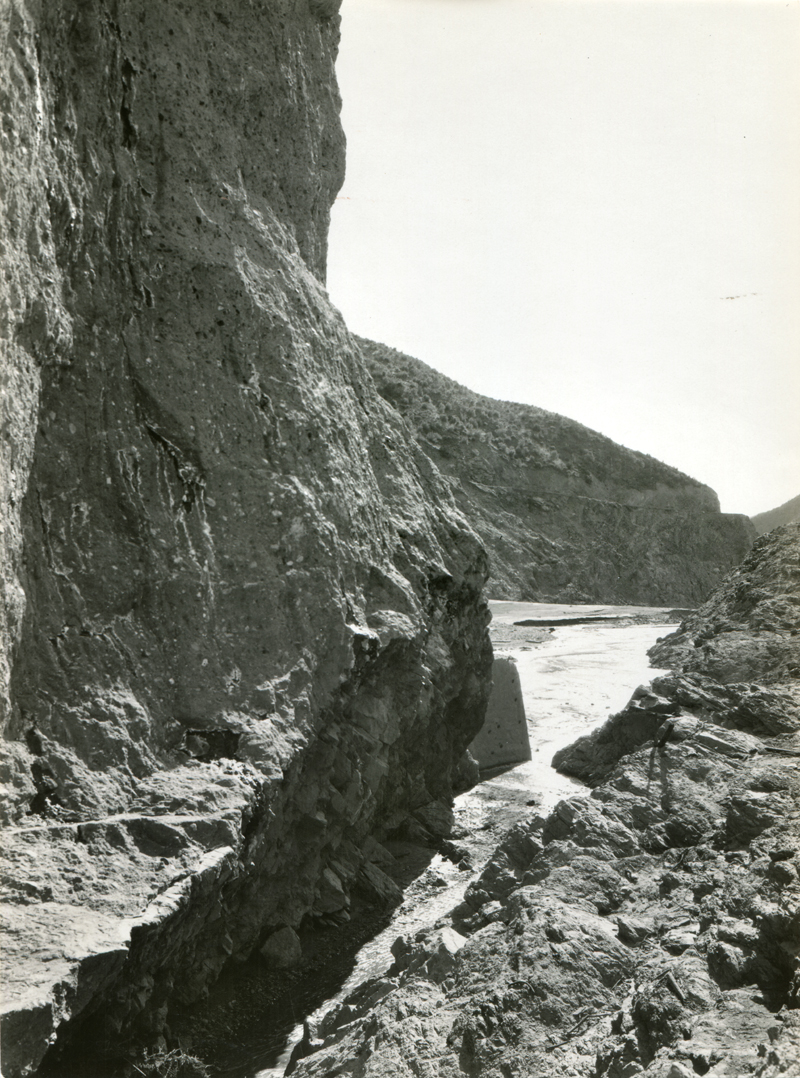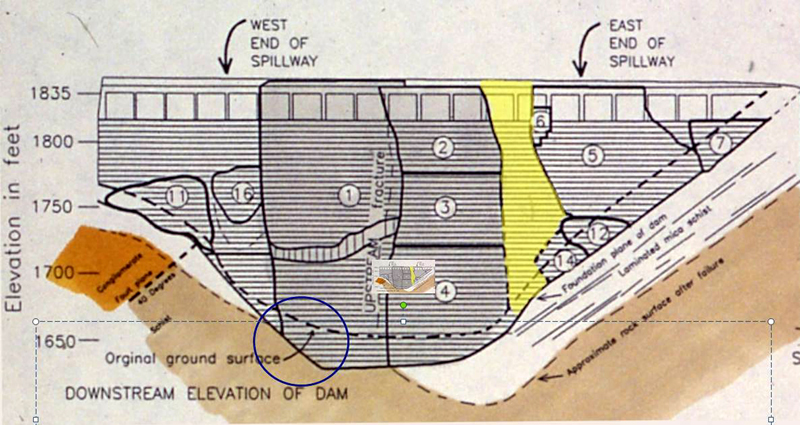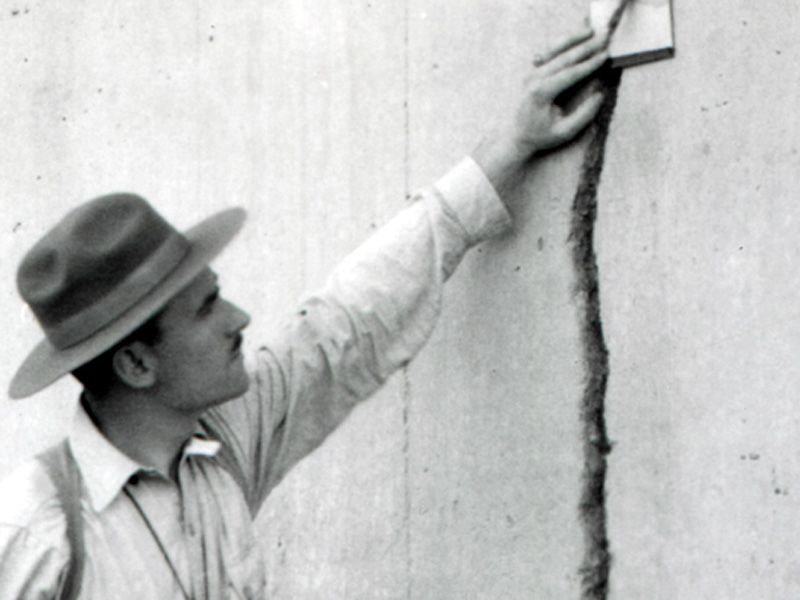|
|
Ex-San Francisco Public Utilities Commission Archives

Click image to enlarge The gulley has been carved through the base of the St. Francis Dam by water evacuating the reservoir. The view is to the south, downstream. Remarks from J. David Rogers, St. Francis Dam engineering expert: This view was taken along the right abutment side of the standing monolith (Block 1), looking downstream. The inclined jagged face of the monolith seen at lower left are pieces of Pelona Schist attached to the dam's concrete, delineating the dam's base of the dam's right abutment (see blue circle on elevation view [below], looking in the opposite direction, upstream). About 20 feet of schist has been eroded away by the outpouring waters of the reservoir, when the right abutment blocks (16 and 11) fell away and were washed a considerable distance downstream. The white marks on the so-called tombstone (Block 1) at left in the photograph are salt stains. Rogers explains that they: ... are from effervescence salts, precipitated from the dam's mass concrete. These were a surprise to many engineers after the dam's failure, because they testified to the mass permeability and saturation of the dam's concrete, which countered most engineer's assumptions in those days. Up to that time most civil engineers erroneously assumed that mass concrete was more or less impermeable, and that dense bedrock materials, like granite, were also impermeable. In fact, these arguments really erupted in the wake of the St. Francis failure (although there were a few engineers who had it right for many years previous, like John R. Freeman). The naysayers were proven incorrect in the 1940s when instrumentation from Hoover Dam was released, which showed that the dam's mass concrete (of much higher density and overall quality than that in St. Francis) exhibited more-or-less instantaneous pore water pressure response to the fluctuating water levels of Lake Mead, through several hundred feet of dense and seemingly impervious mass concrete. The era's greatest engineers were never able to explain the scientific reasons for this response, but they were able to verify it on other instrumented mass concrete dams, such as Grand Coulee and Shasta (built after Hoover Dam). By 1945 they opined that the near-instantaneous pore pressure response must be ascribable to microfissuring, or something similar, which remains the prevailing view.
Photograph shot on or shorly after March 13, 1928. The dam collapsed at 23:57:30 on March 12 and it took about 72 minutes for the 12.5-billion-gallon reservoir to empty (Outland 1977). About the image: One of seventeen 5x7-inch glossy photographs found in a box in the Photography section of the San Francisco Public Utilities Commission's Engineering Archives in 2013.[1] There was no record of the origin of the photographs and no writing on the back to identify subjects or dates. Current SFPUC staff members did not know the reason for their inclusion in the archive. Ownership transferred via email communications (on file) from SFPUC to SCVTV-SCVHistory.com. Prints received July 11, 2014; subsequently transferred to the Santa Clarita Valley Historical Society.
1. A hand-written notation by current San Francisco PUC staff indicates the images were emailed Aug. 8, 2013, to someone who identified them as the St. Francis Dam. SFPUC staff alerted us to their existence in the Spring of 2014.
Construction on the 600-foot-long, 185-foot-high St. Francis Dam started in August 1924. With a 12.5-billion-gallon capacity, the reservoir began to fill with water on March 1, 1926. It was completed two months later. At 11:57:30 p.m. on March 12, 1928, the dam failed, sending a 180-foot-high wall of water crashing down San Francisquito Canyon. An estimated 411 people lay dead by the time the floodwaters reached the Pacific Ocean south of Ventura 5½ hours later. It was the second-worst disaster in California history, after the great San Francisco earthquake and fire of 1906, in terms of lives lost — and America's worst civil engineering failure of the 20th Century.
LW2642l: 19200 dpi jpeg from original 5x7-inch glossy print. |
The site owner makes no assertions as to ownership of any original copyrights to digitized images. However, these images are intended for Personal or Research use only. Any other kind of use, including but not limited to commercial or scholarly publication in any medium or format, public exhibition, or use online or in a web site, may be subject to additional restrictions including but not limited to the copyrights held by parties other than the site owner. USERS ARE SOLELY RESPONSIBLE for determining the existence of such rights and for obtaining any permissions and/or paying associated fees necessary for the proposed use.












